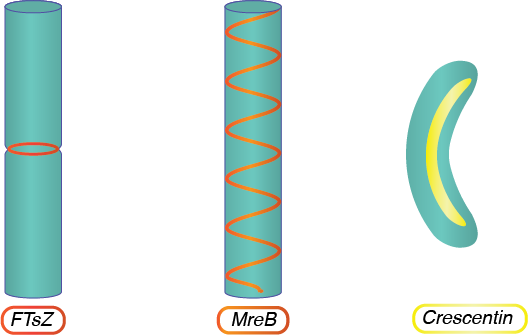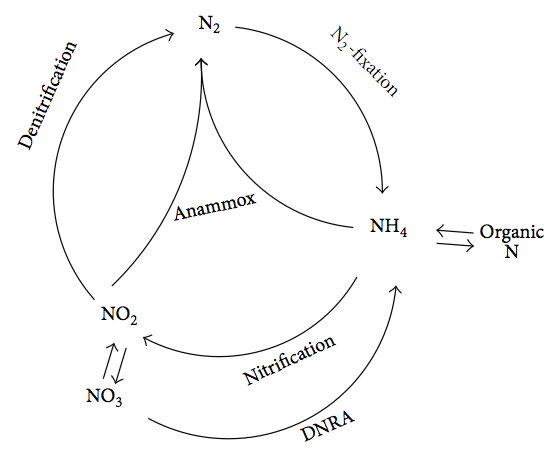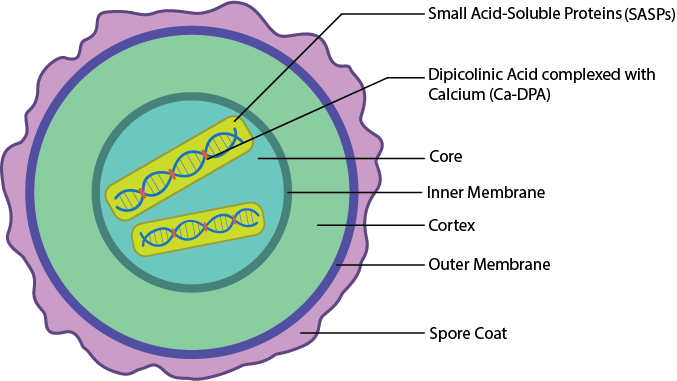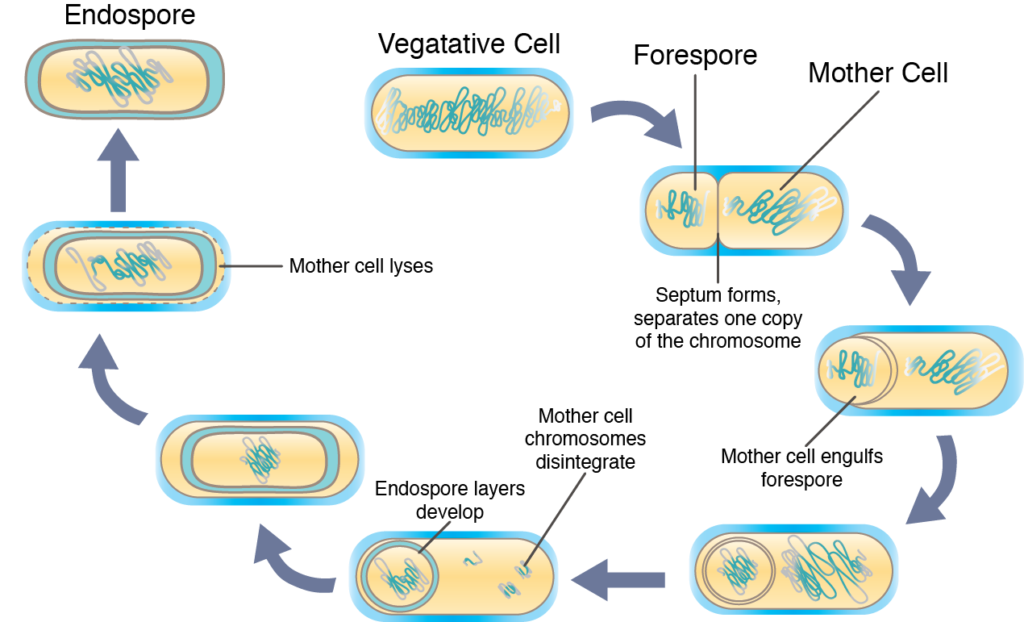what internal structure contributes to cell shape and division
5 Bacteria: Internal Components
We have already covered the chief internal components found in all bacteria, namely, cytoplasm, the nucleoid, and ribosomes. Remember that bacteria are generally thought to lack organelles, those bilipid membrane-bound compartments so prevalent in eukaryotic cells (although some scientists argue that bacteria possess structures that could be idea of as elementary organelles). But bacteria can exist more than complex, with a diversity of additional internal components to be found that can contribute to their capabilities. Virtually of these components are cytoplasmic but some of them are periplasmic, located in the space between the cytoplasmic and outer membrane in gram negative bacteria.
Cytoskeleton
It was originally thought that bacteria lacked a cytoskeleton, a significant component of eukaryotic cells. In the last 20 years, however, scientists take discovered bacterial filaments made of proteins that are analogues to the cytoskeletal proteins found in eukaryotes. Information technology has as well been adamant that the bacterial cytoskeleton plays important roles in jail cell shape, cell partitioning, and integrity of the prison cell wall.
FtsZ
FtsZ, homologous to the eukaryotic protein tubulin, forms a ring construction in the centre of the cell during cell partition, attracting other proteins to the expanse in order to construct a septum that volition eventually carve up the 2 resulting daughter cells.
MreB
MreB, homologous to the eukaryotic poly peptide actin, is plant in bacillus and spiral-shaped bacteria and plays an essential role in prison cell shape formation. MreB assumes a helical configuration running the length of the cell and dictates the activities of the peptidoglycan-synthesis machinery, assuring a non-spherical shape.
Crescentin
Crescentin, homologous to the eukaryotic proteins lamin and keratin, is found in spiral-shaped bacteria with a single bend. The protein assembles lengthwise in the inner curvature of the cell, bending the cell into its final shape.

Inclusions
Bacterial inclusions are by and large defined every bit a distinct construction located either within the cytoplasm or periplasm of the prison cell. They tin range in complexity, from a simple compilation of chemicals such as crystals, to fairly complex structures that start to rival that of the eukaryotic organelles, complete with a membranous external layer. Their role is often to store components equally metabolic reserves for the cell when a substance is found in excess, but they can also play a role in motility and metabolic functions likewise.
Carbon storage
Carbon is the most common substance to exist stored by a cell, since all cells are carbon based. In add-on, carbon compounds can often exist cleaved downward apace by the cell, so they can serve every bit energy sources as well. One of the simplest and most common inclusions for carbon storage is glycogen, in which glucose units are linked together in a multi-branching polysaccharide construction.
Another mutual mode for bacteria to shop carbon is in the form of poly-β-hydroxybutyrate (PHB), a granule that forms when β-hydroxybutyric acid units amass together. This lipid is very plastic-like in composition, leading some scientists to investigate the possibility of using them equally a biodegradeable plastic. The PHB granules actually have a shell composed of both protein and a small corporeality of phospholipid. Both glycogen and PHB are formed when in that location is an excess of carbon so broken down by the jail cell later for both carbon and energy.
Inorganic storage
Often bacteria need something other than carbon, either for synthesis of jail cell components or as an alternate energy reserve. Polyphosphate granules permit for the accumulation of inorganic phosphate (PO43-), where the phosphate can be used to make nucleic acid (remember the sugar-phosphate backbone?) or ATP (adenosine triphosphate, of course).
Other cells need sulfur as a source of electrons for their metabolism and will store excess sulfur in the course of sulfur globules, which outcome when the prison cell oxidizes hydrogen sulfide (H2S) to elemental sulfur (S0), resulting in the formation of refractile inclusions.
Non-storage functions
There are times when a bacterium needs to do something beyond simple storage of organic or inorganic compounds for use in metabolism and there are inclusions to assistance with these non-storage functions. 1 such example is gas vacuoles, which are used by the cell to control buoyancy in a water column, providing the prison cell with some control over where it is in the surroundings. It is a limited form of movement, on the vertical axis only. Gas vacuoles are equanimous of conglomerations of gas vesicles, cylindrical structures that are both hollow and rigid. The gas vesicles are freely permeable to all types of gases by passive diffusion and can be rapidly constructed or complanate, as needed by the cell to ascend or descend.
Magnetosomes are inclusions that incorporate long chains of magnetite (Fe3O4), which are used by the cell as a compass in geomagnetic fields, for orientation within their environment. Magnetotactic bacteria are typically microaerophilic, preferring an environs with a lower level of oxygen than the temper. The magenetosome allows the cells to locate the optimum depth for their growth. Magenetosomes take a true lipid bilayer, reminiscent of eukaryotic organelles, but it is really an invagination of the cell'southward plasma membrane that has been modified with specific proteins.
Microcompartments
Bacterial microcompartments (BMCs) are unique from other inclusions by virtue of their construction and functionality. They are icosahedral in shape and equanimous of a protein trounce made upwardly of various proteins in the BMC family unit. While their exact part varies, they all participate in functions beyond simple storage of substances. These compartments provide both a location and the substances (ordinarily enzymes) necessary for detail metabolic activities.
The best studied instance of a BMC is the carboxysome, which are found in many CO2-fixing bacteria. Carboxysomes contain the enzyme ribulose-i,5-bisphosphate carboxylase (luckily it is as well known as RubisCO), which plays a crucial role in converting CO2 into sugar. The carboxysome also plays a office in the concentration of CO2, thus ensuring that the components necessary for CO2-fixation are all in the same place at the same fourth dimension.
Anammoxosome
The anammoxosome is a large membrane-bound compartment found in bacterial cells capable of carrying out the anammox reaction (anaerobic ammonium oxidation), where ammonium (NH4+) and nitrite (NO2-) are converted to dinitrogen gas (N2). The process is performed equally a way for the jail cell to go energy, using ammonium equally an electron donor and nitrite as an electron accept, with the resulting production of nitrogen gas. This chemic conversion of nitrogen is important for the nitrogen cycle.

Chlorosome
Found in some phototrophic bacteria, a chlorosome is a highly efficient structure for capturing depression light intensities. Lining the inside perimeter of the jail cell membrane, each chlorosome can contain up to 250,000 bacteriochlorophyll molecules, arranged in dumbo arrays. Harvested light is transferred to reaction centers in the cell membrane, allowing the conversion from light energy to chemical energy in the course of ATP. The chlorosome is bounded by a lipid monolayer.
Plasmid
A plasmid is an extrachromosomal piece of Dna that some bacteria have, in improver to the genetic material plant in the nucleoid. It is equanimous of double-stranded Deoxyribonucleic acid and is typically circular, although linear plasmids have been found. Plasmids are described as beingness "non-essential" to the cell, where the cell tin function normally in their absence. But while plasmids have merely a few genes, they can confer important capabilities for the prison cell, such equally antibody resistance. Plasmids replicate independently of the cell and can be lost (known as curing), either spontaneously or due to exposure to adverse conditions, such as UV light, thymine starvation, or growth above optimal atmospheric condition. Some plasmids, known as episomes, can be integrated into the cell chromosome where the genes will be replicated during cell division.
Endospore
Then there is the endospore, a marvel of bacterial engineering science. This is located under the heading "bacterial internal components," but it is important to note that an endospore isn't an internal or external structure so much as a conversion of the cell into an alternate form. Cells start out as a vegetative cell, doing all the things a jail cell is supposed to do (metabolizing, reproducing, mowing the lawn…). If they get exposed to hostile conditions (dessication, loftier rut, an angry neighbor…) and they have the ability, they might convert from a vegetative cell into an endospore. The endospore is actually formed within the vegetative cell (doesn't that make information technology an internal structure?) and then the vegetative cell lyses, releasing the endospore (does that brand it an external construction?).

Endospores are only formed past a few gram positive genera and provide the cell with resistance to a wide variety of harsh weather, such equally starvation, extremes in temperature, exposure to drying, UV light, chemicals, enzymes, and radiation. While the vegetative cell is the agile form for bacterial cells (growing, metabolizing, etc), the endospore can be thought of every bit a fallow form of the cell. Information technology allows for survival of adverse atmospheric condition, but information technology does not allow the jail cell to grow or reproduce.
Structure
In order to be and so incredibly resistant to and then many different substances and environmental conditions, many different layers are necessary. The bacterial endospore has many different layers, starting with a core in the center. The cadre is the location of the nucleoid, ribosomes, and cytoplasm of the cell, in an extremely dehydrated form. It typically contains only 25% of the water plant in a vegetative cell, increasing estrus resistance. The DNA is further protected by the presence of pocket-sized acid-soluble proteins (SASPs), which stabilize the Dna and protect it from degradation. Deoxyribonucleic acid stabilization is increased by the presence of dipicolinic acrid complexed with calcium (Ca-DPA), which inserts between the Deoxyribonucleic acid bases. The core is wrapped in an inner membrane that provides a permeability bulwark to chemicals, which is and then surrounded by the cortex, a thick layer consisting of peptidoglycan with less cross-linking than is found in the vegetative cell. The cortex is wrapped in an outer membrane. Lastly are several spore coats made of protein, which provide protection from environmental stress such as chemicals and enzymes.
Sporulation: conversion from vegetative cell to endospore
Sporulation, the conversion of vegetative cell into the highly protective endospore, typically occurs when the prison cell'due south survival is threatened in some way. The bodily process is very circuitous and typically takes several hours until completion. Initially the sporulating cells replicates its Deoxyribonucleic acid, as if it were about to undergo cell division. A septum forms asymmetrically, sequestering 1 copy of the chromosome at one end of the cell (chosen the forespore). Synthesis of endospore-specific substances occurs, altering the forespore and leading to the evolution of the layers specific for an endospore, also as dehydration. Somewhen the "mother cell" is lyses, allowing for the release of the mature endospore into the surroundings.

Conversion from endospore to vegetative prison cell
The endospore remains fallow until ecology conditions improve, causing a chemical change that initiates cistron expression. There are three distinct stages in the conversion from an endospore to the metabolically agile vegetative cells: 1) activation, a training footstep that can be initiated by the awarding of heat; two) formation, when the endospore becomes metabolically agile and begins to accept on water; 3) outgrowth, when the vegetative cell fully emerges from the endospore shell.
Primal Words
cytoskeleton, FtsZ, tubulin, MreB, actin, crescentin, lamin, keratin, inclusion, glycogen, poly-β-hydroxybutyrate (PHB), polyphosphate granule, sulfur globule, gas vacuole, gas vesicle, magnetosome, microaerophilic, microcompartment, bacterial microcompartments (BMCs), carboxysome, ribulose-1,5-bisphosphate carboxylase, RubisCO, anammoxosome, anammox reaction, chlorosome, plasmid, curing, episome, endospore, vegetative cell, core, pocket-size acid-soluble proteins (SASPs), dipicolinic acid, Ca-DPA, inner membrane, cortex, outer membrane, spore coat, sporulation, forespore, activation, formation, outgrowth.
Report Questions
- What are the roles and composition of the bacterial cytoskeleton? How does it differ from the eukaryotic cytoskeleton? What are the specific bacterial cytoskeleton proteins and what details are known about each?
- What is the purpose of inclusions constitute in bacteria? What are their characteristics?
- What are the specific examples of storage inclusions found in bacteria? Be able to describe each type in terms of structure and purpose.
- What are other inclusions found in bacteria? Be able to describe each type in terms of construction and purpose.
- How exercise microcompartments differ from inclusions? What are specific examples? What is the limerick and purpose?
- What are anammoxosomes? What is their limerick and purpose?
- What are plasmids and what characteristics do they have? What are episomes? What is curing and what causes it?
- What are bacterial endospores? What is their purpose? What characteristics do they have? What are the various layers of an endospore and what office does each layer play?
Exploratory Questions (OPTIONAL)
- What bacterial structures could exist useful to scientists in addressing societal problems?
smiththerecomed1949.blogspot.com
Source: https://open.oregonstate.education/generalmicrobiology/chapter/bacteria-internal-components/
0 Response to "what internal structure contributes to cell shape and division"
Post a Comment